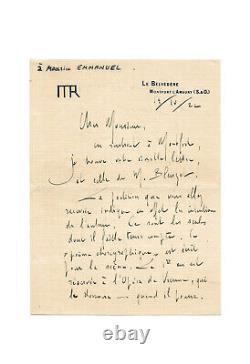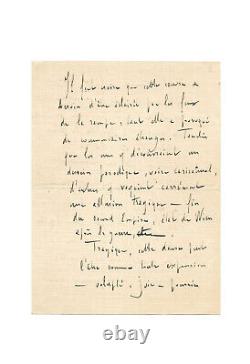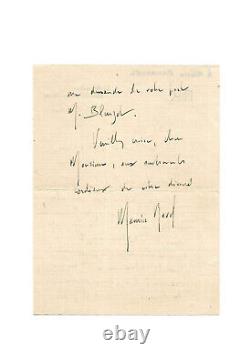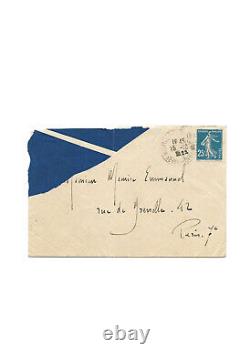
- Homepage
- Author
- Anatole France (3)
- Beydts (louis) (4)
- Camille Mauclair (3)
- Charles Monselet (3)
- Chateaubriand (5)
- Colette (3)
- Ernest Daudet (3)
- Eugène Labiche (3)
- Jean Couty (3)
- Jean-léon Gérôme (5)
- Julien DuprÉ (3)
- Louise Read (4)
- Marcel Proust (5)
- Paul Chabas (4)
- Paul Meurice (3)
- Proust (3)
- Roger Martin Du Gard (4)
- Salomon Reinach (3)
- Sully Prudhomme (7)
- Violette Leduc (4)
- Other (3909)
- Era
- 18th Century (10)
- 1900 To 1960 (55)
- 1960s (5)
- 1970s (7)
- 19th (5)
- 19th Century (46)
- 20th Century (12)
- Beautiful Era (12)
- Belle Epoque (49)
- First Empire (7)
- First World War (4)
- Nineteenth (17)
- Nineteenth Century (7)
- Post-war (21)
- Restoration (15)
- Revolution (4)
- Roaring Twenties (27)
- Second Empire (20)
- Second World War (5)
- World War Ii (9)
- Other (3647)
- Language
- Period
- Region
- Theme
Maurice RAVEL / Signed Autograph Letter / La Valse / Critique / Performance







Signed autograph letter "Maurice Ravel" to Maurice Emmanuel Le Belvédère, Montfort-l'Amaury S., "14/10/[19]22", 4 p.
In-8° With autographed stamped and canceled envelope (cut in upper left margin) Annotation "à Maurice Emmanuel" by another hand. Famous and important letter in which Ravel reacts to criticism of La Valse, his first major work after the war, while explaining its artistic significance. I find your kind letter, and that of Mr.
The score that you will receive indeed indicates the author's intentions. These are the only ones that should be taken into account. This "choreographic poem" is written for the stage. The first part is reserved for the Vienna Opera, which will perform it. It must be believed that this work needs to be illuminated by the spotlight, as it has provoked strange comments. While some discovered a parodic, even caricatural, design in it, others saw it as a tragic allusion - end of the Second Empire, being from Vienna after the war, etc. Tragic, this dance can be like any expression - pleasure, joy - pushed to the extreme. Only what the music expresses should be seen in it: an ascending progression of sonority.To which the stage will add that of light and movement. I think Durand must have sent you the brochure by Roland-Manuel, in which you will find, better than I could give them to you, all the information that Mr. asks for on your behalf. Please believe, dear Sir, in the cordial feelings of your devoted Maurice Ravel". [1] Ravel had just returned from Holland where he had taken part in the festival of contemporary French music organized at the Concertgebouw in Amsterdam from September 27 to October 1.
[3] In 1928, Maurice Ravel will make an even more pronounced "ascending progression of sonority" with Le Boléro. A choreographic poem for orchestra, it was composed by Ravel between 1919 and 1920 and publicly premiered on December 12, 1920 by the Lamoureux Concerts. However, its genesis dates back to 1906. In agreement with Serge de Diaghilev, Ravel intended to compose an Apotheosis of the Waltz for the ballet as a tribute to Johann Strauss. However, World War I forced him to postpone his plans and changed the composer's initial ambitions.
The romantic and sumptuous evocation of the Viennese court of the 19th century, so well represented by Johann Strauss II's waltzes, was replaced by the image of a decadent world. Ravel composed La Valse with determination, as an outlet, and completed it in less than five months, deliberately disfiguring the Viennese waltz while depicting a "fantastic and fatal whirlwind." Rejected by the Ballets Russes in 1920 during a first audition that marked the definitive rupture between Ravel and Diaghilev, and despite mixed reviews, the work still met with immense success in concert and was eventually adapted for the theater in 1929 for Ida Rubinstein's ballets. It bears the reference M.
72 in the composer's catalog established by the musicologist Marcel Marnat. 205-206, n°206 Maurice Ravel, The Complete Works, ed. Manuel Cornejo, Le Passeur, p.
Maurice Ravel, National Library, 1975, n°323. Maurice Emmanuel Then Frank Emmanuel, by descent Then private collection.

